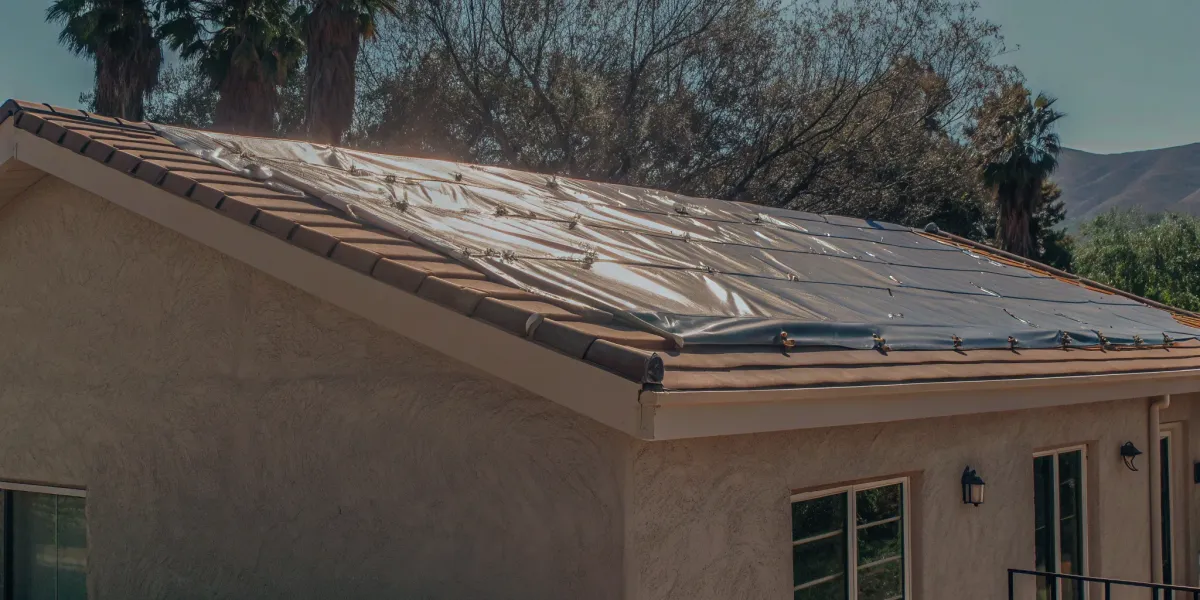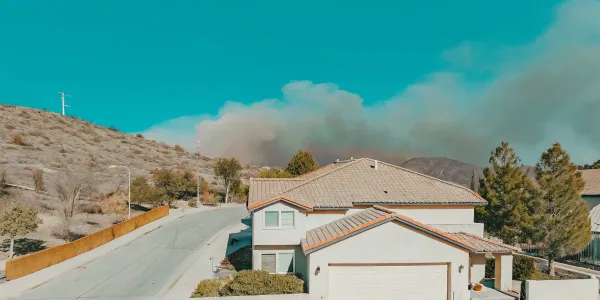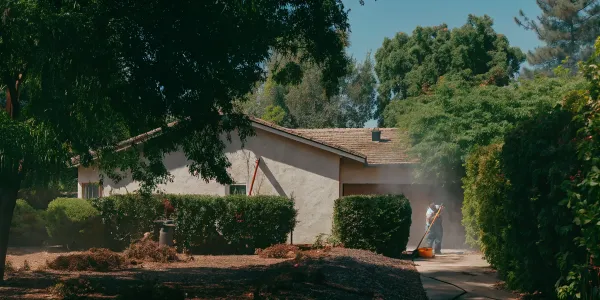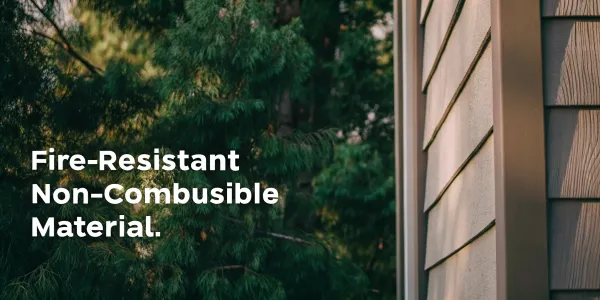Fire Retardant Roof Coatings: A Homeowner's Guide
Protect your home with a fire retardant roof coating. Learn how these coatings work, what to look for, and how to choose the best option for your roof.

During a wildfire, the biggest threat to your home often isn't the giant wall of flames, but the storm of tiny, wind-blown embers that can travel for miles. These embers land on your roof, looking for a place to ignite. Since your roof is a large, exposed surface, it’s the first line of defense—and the most common point of failure. While a full roof replacement is a massive expense, there is a more accessible solution. Applying a fire retardant roof coating can transform your existing roof into a resilient, fire-resistant barrier. This article will show you how this technology works to protect your home where it matters most.
Key Takeaways
- Coatings Stop Embers Cold: These products create a protective barrier that swells when heated, forming an insulating char layer that stops wind-blown embers from igniting your roof—your home's most vulnerable surface.
- Prioritize the Class A Fire Rating: This top-tier rating, verified by tests like UL 790, is the most credible proof of fire resistance you can show your insurance carrier to demonstrate you've reduced your home's risk.
- Application and Upkeep Determine Success: A coating's performance depends entirely on proper surface preparation and consistent maintenance. Whether you DIY or hire a pro, don't skip the prep work or the annual inspections.
What Are Fire Retardant Roof Coatings?
When you’re looking for ways to protect your home from wildfire, your roof is the first line of defense. It’s the most vulnerable part of your house, especially when it comes to airborne embers. That’s where fire retardant roof coatings come in. Think of them as a protective shield for your existing roof. These are specially formulated liquid products applied to your roofing materials to make them less flammable. Instead of replacing your entire roof, a coating can add a critical layer of protection, slowing the spread of flames and giving your property a better chance of survival.
How Do They Work to Protect Your Home?
So, how does a layer of liquid actually stop a fire? The science is pretty smart. When a fire retardant coating is exposed to intense heat from flames or embers, it triggers a chemical reaction. The coating quickly expands and swells, forming a thick, insulating char layer. This layer acts as a barrier, shielding the roofing material underneath from the heat and cutting off the oxygen that fire needs to burn. Some coatings also contain ingredients that release water vapor when heated. This process actively cools the roof’s surface, making it much harder for your roof to catch fire.
Common Types and What They're Made Of
Not all fire retardant coatings are the same. The most common types you’ll find are elastomeric coatings. "Elastomeric" just means they are flexible and rubber-like, which is great because they can expand and contract with your roof through changing weather without cracking. This durability makes them a popular choice for long-term protection. These coatings are often made with a blend of polymers and inorganic compounds that are naturally fire-resistant. The goal is to find a product that not only resists fire but also stands up to sun, rain, and wind, ensuring your investment continues to protect your home.
Understanding the Environmental Impact
It’s natural to wonder if the chemicals used to fight fire are safe for your family and the environment. In the past, some fire retardants contained compounds like bromine or chlorine, which raised concerns about toxicity. When these chemicals burn, they can release harmful substances. The good news is that the industry is moving toward safer options. Many manufacturers now offer low-VOC (volatile organic compounds) or water-based coatings. Researchers are also developing eco-friendly flame retardants to reduce environmental impact. When you’re shopping, look for products that are transparent about their ingredients and prioritize environmental safety.
What Do the Safety Ratings Mean?
When you’re choosing a coating, you’ll see safety ratings like "Class A" or "Class B." These aren't just marketing terms; they are official classifications based on rigorous testing. For a product to be sold as fire-resistant, it has to be evaluated by a recognized organization like UL (Underwriters Laboratories) using a standard test known as ASTM E108. This test simulates fire exposure to see how well the roofing material performs. A Class A fire rating is the highest rating a roofing material can achieve, indicating it can withstand severe fire exposure. For homeowners in high-risk wildfire areas, choosing a Class A-rated product is a critical step.
Why Use a Fire Retardant Coating?
When you live in a high-risk fire area, it’s easy to feel like the threat is out of your control. But taking proactive steps to harden your home can make a significant difference, and your roof is the best place to start. Your roof is the single most vulnerable surface on your home, acting as a large, flat catcher for wind-blown embers that can travel a mile or more ahead of a wildfire. Applying a fire retardant coating is a powerful, direct action you can take to reduce the chances of those embers igniting your home.
Think of it as adding a specialized shield to your first line of defense. These coatings do more than just resist fire; they offer a suite of benefits that make them a smart investment for any homeowner concerned about resilience. Beyond the critical protection during a wildfire, many of these coatings can also improve your home's energy efficiency, extend the life of your existing roof, and potentially make your home more attractive to insurance carriers. It’s one of the few home improvement projects that protects your property, saves you money on utility bills, and helps you address the ongoing insurance crisis all at once.
How They Defend Against Embers and Flames
The real magic of a fire retardant coating is how it reacts to intense heat. When exposed to flames or hot embers, the coating undergoes a chemical reaction, swelling up to form a thick, carbonized layer of char. This process, known as intumescence, creates an insulating barrier that shields the roofing materials underneath from igniting. Instead of allowing an ember to smolder and burn through your roof deck, the coating effectively suffocates it. This is especially critical for protecting vulnerable materials like wood shakes, but it adds a crucial layer of protection to nearly any roof type by preventing a small ember from becoming a catastrophic fire.
The Advantage of Better Energy Efficiency
Many fire retardant coatings double as “cool roof” coatings, meaning they are designed with highly reflective surfaces. These coatings, often white or light-colored, reflect a significant amount of the sun’s thermal energy instead of absorbing it. This simple feature can dramatically lower the temperature of your roof surface, which in turn keeps your attic and the rest of your home cooler during hot summer months. The result? Your air conditioning system doesn’t have to work as hard, leading to lower energy bills. This benefit pays you back year after year, making the initial investment in a coating even more cost-effective.
Extending the Life of Your Roof
Your roof takes a constant beating from the elements—scorching sun, heavy rain, and wind. Over time, this exposure degrades the roofing materials, leading to cracks, leaks, and the eventual need for a costly replacement. A fire retardant coating adds a durable, seamless membrane over your existing roof, acting as a protective barrier against UV radiation and moisture. By slowing the aging process of the materials underneath, the coating can add years to the life of your roof, helping you protect one of your home’s most important and expensive components.
Can They Help Lower Your Insurance Premiums?
In today’s tough insurance market, demonstrating that you’ve taken steps to reduce your wildfire risk is essential. While no single upgrade guarantees a discount, having a Class A fire-rated roof is one of the most impactful measures you can take. Applying a certified fire retardant coating can help your roof assembly achieve this top rating. Insurers see a home with a fire-resistant roof as a lower risk, which can make it easier to obtain or keep your coverage. Be sure to document the installation with photos and product certifications to share with your insurance agent.
What Kinds of Roofs Are Compatible?
One of the biggest advantages of fire retardant coatings is their versatility. They are formulated to adhere to a wide variety of roofing materials, making them a viable option for most homes. Whether your roof is made of asphalt shingles, wood shakes or shingles, metal panels, concrete tiles, or built-up roofing (BUR), there is likely a compatible coating available. It’s always important to read the manufacturer’s specifications carefully to ensure the product you choose is right for your specific roof type and to follow the recommended surface preparation steps for proper adhesion and performance.
Use on Commercial and Industrial Buildings
If you need proof of their effectiveness, look no further than the commercial building sector. Fire retardant roof coatings are widely used on industrial buildings, warehouses, schools, and hospitals, where fire safety codes are incredibly strict. For these large, often flat-roofed structures, coatings provide a reliable and cost-effective way to meet stringent fire-resistance standards and protect valuable assets and occupants. The widespread adoption in commercial applications underscores the technology's credibility and proven performance, giving homeowners confidence that they are using a trusted, professional-grade solution to protect their property.
How to Choose the Right Coating
Selecting the right fire retardant coating can feel overwhelming, but focusing on a few key factors will help you make a confident choice. Your goal is to find a product that not only meets safety standards but also suits your specific roof type, climate, and budget. Think of this as a critical upgrade to your home's defense system. A quality coating is an investment in your property's resilience and your family's safety, helping you take proactive control in the face of wildfire risk. By understanding what to look for, you can cut through the marketing noise and choose a product that delivers real protection when it matters most.
Key Features to Look For
When you’re serious about fire protection, the single most important feature is the product's fire rating. You should look for a Class A roof rating, which provides the highest available level of fire resistance against severe exposure. Beyond that, consider the coating's durability and weather resistance. A good product should withstand UV rays, rain, and temperature changes without cracking or peeling. Also, check for compatibility with your existing roofing material, whether it's asphalt shingles, metal, or tile. Some coatings are formulated for specific surfaces, so confirming this upfront is essential for proper adhesion and long-term performance.
Comparing Top Brands and Products
To be sold as fire-resistant, roofing products must meet criteria set by recognized testing organizations. The key standard to look for is UL 790 (also known as ASTM E108). When comparing brands, check their technical data sheets for this certification. Don’t just rely on marketing claims; look for independent, third-party verification. Read customer reviews and ask for recommendations from local roofing professionals who have experience with products that perform well in your area. Comparing warranties and the chemical makeup of different coatings will also give you a clearer picture of which product offers the best value and safety for your home.
What to Expect for Costs
The cost of a fire retardant roof coating is an investment in protecting your most valuable asset. A home with a fire-resistant roof is less likely to suffer major fire damage, making it a more stable investment for you and a lower risk for insurers. Prices vary based on the brand, the size and complexity of your roof, and whether you hire a professional for installation. While it might be tempting to choose the cheapest option, a higher-quality coating often provides better long-term protection and durability, saving you money on reapplication or potential repairs down the line.
Understanding Warranty Coverage
A product warranty offers a layer of assurance, but it’s important to understand what it actually covers. Most warranties protect against manufacturing defects that cause the coating to peel, blister, or crack under normal conditions. However, they typically don't cover issues arising from improper application, structural problems with your roof, or damage from severe weather events. Read the fine print carefully to understand the warranty's duration, limitations, and any maintenance requirements needed to keep it valid. A strong warranty from a reputable company can be a good indicator of a product’s quality.
A Look at Chemical Composition
Many homeowners have valid concerns about the potential toxicity of fire retardant products. Historically, some contained chemicals like bromine or chlorine. However, the industry has shifted toward safer formulations. Today, many leading roof coatings are water-based and have low levels of Volatile Organic Compounds (VOCs), making them safer for both the environment and the people applying them. When choosing a product, look for transparency in its chemical makeup. Brands that clearly list their ingredients and highlight their eco-friendly or low-toxicity properties are often a more responsible choice for your home and family.
How to Read Performance Ratings
Understanding performance ratings is the best way to ensure you’re getting the protection you pay for. As mentioned, certifications must meet the criteria set by recognized testing organizations like UL. The UL 790 (ASTM E108) test is the industry standard, and it assigns one of three fire-resistance ratings:
- Class A: The highest rating, effective against severe fire exposure. This is the standard you should aim for in a high-risk wildfire area.
- Class B: Effective against moderate fire exposure.
- Class C: Effective against light fire exposure.
These ratings are clearly marked on the product label or technical data sheet, empowering you to make an informed decision based on proven performance.
Factors That Affect Durability
Several factors determine how long your fire retardant coating will last. The quality of the product is a major one, but proper application is just as critical. The roof surface must be thoroughly cleaned and prepared before the coating is applied to ensure strong adhesion. The climate in your area also plays a role; intense UV exposure and frequent rain can wear down a coating over time. Keep in mind that some roofs aren't eligible for coatings, and these applications can become slippery when wet. Regular inspection and maintenance are key to maximizing the coating's lifespan and are an essential part of your overall Wildfire Action Plan.
Applying and Maintaining Your Coating
Once you’ve chosen a fire retardant coating, the next step is getting it on your roof correctly. Proper application and consistent maintenance are just as important as the product itself. A well-applied coating can be the difference-maker when embers land on your home, but a poorly applied one might not offer the protection you’re counting on. This section walks you through the process, from preparation to long-term care, so you can feel confident in your roof’s added layer of defense.
Should You Hire a Pro or Do It Yourself?
Deciding between a DIY project and hiring a professional comes down to your budget, skills, and comfort level with heights. Applying a roof coating yourself can save you a significant amount of money on labor. However, it’s a demanding job that requires physical fitness, the right equipment, and a strict adherence to safety protocols. If you’re not careful, you could end up with an uneven application that compromises the coating’s effectiveness or, worse, suffer a serious fall.
Hiring a licensed roofing contractor costs more, but you’re paying for expertise and peace of mind. A professional will have the experience to properly prep the surface and apply the coating for maximum durability and protection. They also carry their own insurance and can often guarantee their work, which can be crucial for meeting warranty requirements.
How to Prepare Your Roof Surface
You can’t just slap a new coating onto a dirty roof. Proper surface preparation is the most critical step for ensuring the coating sticks and performs as it should. Start by thoroughly cleaning the entire roof. It needs to be completely free of dirt, leaves, moss, oil, or any loose debris. For most roofs, a pressure washer is the most effective tool for the job.
After cleaning, inspect the surface for any damage like cracks, blisters, or loose shingles, and make all necessary repairs. The coating is a protective layer, not a structural fix. Finally, make sure the roof is completely dry before you begin. Trapped moisture can prevent the coating from adhering correctly and lead to bubbling or peeling down the road.
The Step-by-Step Application Process
Always start by reading the manufacturer’s instructions—they are your most important guide. While the specifics can vary between products, the general process is similar. Most coatings can be applied with a high-quality roller, brush, or an airless paint sprayer. A sprayer often gives the most uniform finish, but a roller works well for many homeowners.
Apply the coating in a thin, even layer across the entire surface, working in manageable sections. Pay close attention to the recommended thickness, as applying it too thin will reduce its effectiveness. Many products require two coats for optimal performance. Be sure to let the first coat dry completely for the time specified in the instructions before applying the second.
Safety Measures to Follow
Working on a roof is inherently risky, so safety must be your top priority. Always use a sturdy, properly secured ladder. If you’re working on a sloped roof, a safety harness is essential. It’s also wise to have a spotter on the ground. Wear non-slip shoes with good grip, and never work on a wet or windy day.
When handling the coating itself, wear protective gear, including gloves, safety glasses, and a respirator to avoid inhaling fumes. Keep the product containers sealed when not in use and follow proper safety and health considerations for storage in a cool, well-ventilated area away from heat or potential sparks. Make sure you have a clear plan for what to do in case of a spill.
Your Long-Term Maintenance Checklist
A fire retardant coating isn’t a “set it and forget it” solution. To keep it effective, you’ll need to perform regular maintenance. Create a simple annual checklist to stay on top of it:
- Inspect: At least once a year and after any major storm, walk your roof (if you can do so safely) to look for signs of wear and tear like cracking, peeling, or blistering.
- Clean: Gently sweep or use a leaf blower to remove leaves, pine needles, and other debris. Accumulated organic matter can hold moisture and break down the coating over time.
- Repair: If you find small areas of damage, address them immediately. Clean the spot and apply a touch-up coat according to the manufacturer’s directions to prevent the damage from spreading.
How to Monitor Performance Over Time
Beyond your own annual inspections, it’s a good idea to have a professional roofer assess the coating’s condition every few years. They can identify subtle signs of degradation that you might miss and can test the coating’s adhesion and thickness to ensure it’s still providing adequate protection.
This professional check-up is also important for your records. Keeping a log of inspections and any maintenance performed can be valuable if you ever need to file a warranty claim. It also provides documentation of your home hardening efforts, which can be helpful when discussing your property’s risk profile with your insurance provider. A well-maintained, fire-resistant roof is a key part of a strong Wildfire Action Plan.
Meeting Local Codes and Regulations
Before you purchase or apply any coating, check with your local building department or fire marshal. Many communities in high-risk fire zones have specific requirements for roofing materials. Your goal should be to achieve a Class A roof rating, which is the highest level of fire resistance a roof can have. This rating means the roofing system can withstand severe fire exposure.
Using a product that is tested and certified to meet these standards is crucial not only for safety but also for compliance. Failing to meet local codes could result in fines or issues when you try to sell your home. Furthermore, demonstrating that your roof meets Class A standards is a powerful step in showing insurance companies that you are proactively reducing your home’s wildfire risk.
Related Articles
- Class A Fire Rated Roofing Material Price Guide
- 5 Best Fire-Resistant Roofing Materials
- Class A Roofing 101: Everything You Need to Know
- Class A Roof Assembly: A Homeowner's Guide
- What Is a Class A Roof Assembly? A Complete Guide
Frequently Asked Questions
Will a fire retardant coating guarantee my insurance company will cover me or give me a discount? While there are no guarantees in the current insurance market, adding a certified fire retardant coating is one of the most powerful steps you can take. Insurers want to see that you are actively reducing your property's risk, and achieving a Class A fire-rated roof assembly is a major milestone. It can make a significant difference in your ability to find or keep coverage. Be sure to document the product you used and the professional installation, then share that information directly with your agent.
Is applying a coating a good substitute for replacing an old, worn-out roof? Think of a fire retardant coating as a protective shield, not a structural repair. It’s designed to be applied to a roof that is already in good, stable condition. If your roof has existing issues like leaks, widespread cracking, or failing shingles, a coating will only cover up those problems temporarily. You should always address any underlying damage first to ensure the coating can adhere properly and provide the protection you’re paying for.
How long does a fire retardant coating last, and what kind of upkeep does it need? The lifespan of a coating depends on the quality of the product, your local climate, and how well it was applied, but many high-quality coatings can last for ten years or more. To get the most out of your investment, plan on performing a simple inspection each year. This involves clearing off leaves and debris and looking for any signs of peeling or cracking, especially after a major storm. Catching and repairing small spots early will help the entire system last much longer.
What is the single most important factor to look for when choosing a coating? If you live in a wildfire-prone area, the most critical feature is a Class A fire rating. This is the highest level of fire resistance a roofing material can achieve, based on standardized tests (like UL 790 or ASTM E108) that simulate severe fire exposure. Don't just rely on marketing language on the front of the can; look for this specific certification on the product’s technical data sheet to ensure you’re getting proven protection.
Are the chemicals in these coatings safe for my family and the environment? This is a valid concern, and the good news is that the industry has made significant progress. Many modern fire retardant coatings are water-based and formulated to have low VOCs (Volatile Organic Compounds), making them much safer for the air and the people applying them. When comparing products, look for brands that are transparent about their ingredients and specifically mention being low-VOC or environmentally friendly.




